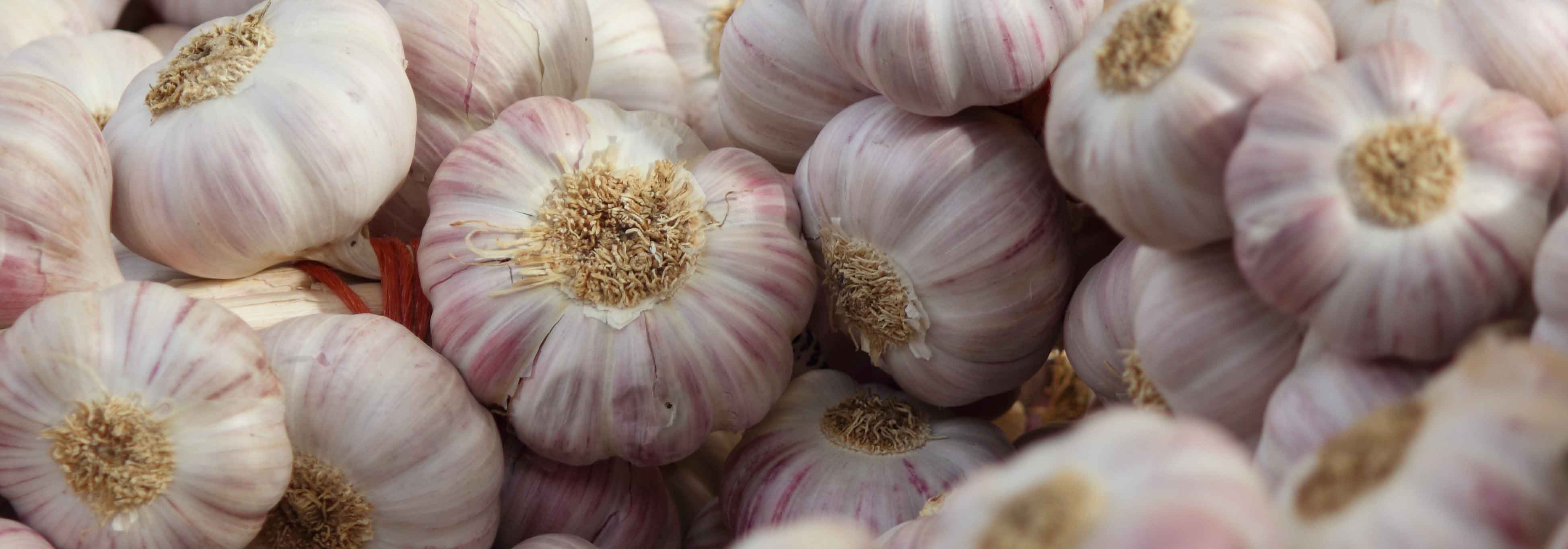
Garlic: planting, growing, harvesting in the vegetable garden
Contents
Garlic in a nutshell
- Garlic is a strong-smelling young plant with a pungent flavour used as a condiment with numerous health benefits.
- It is grown in sunlight, in well-tilled, light, drained soil without fresh manure.
- Garlic is planted at two times of the year: purple garlic and white garlic in autumn, and pink garlic in spring.
- Maintenance is limited to regular weeding and hoeing, as well as watering in case of drought.
- It is harvested at different stages of ripeness, as garlic shoots, fresh or green for autumn varieties, and most commonly when dry.
A word from our expert
The garlic is a root vegetable from the Liliaceae family which includes many other vegetable and aromatic plants such as onion, shallot, leek, spring onion, and chives. There are different categories of garlic which are white garlic, purple garlic, the strongest, and pink garlic, the mildest in taste. Garlic is consumed as a condiment, raw or cooked, as garlic shoots, green garlic, or most commonly, dried. It enhances and flavours many dishes and is notably used in the preparation of aioli and snail butter.
Growing garlic is not difficult as long as you have loose, well-drained soil, free from fresh manure and exposed to sunlight. White garlic and purple garlic are planted in autumn while pink garlic is planted in spring. The first two will yield a very good harvest, whereas pink garlic will produce smaller bulbs and bulbils that will keep for longer. It is therefore interesting, as a gardener, to test the different types to identify those that are best suited to your growing conditions. You may be lucky enough to find that all thrive in your vegetable garden; in that case, if you enjoy this condiment, do not hesitate to diversify the varieties!
The reputation, quality, and production expertise of garlic is highlighted in France with currently four PGIs (Protected Geographical Indication). These concern white garlic from Lomagne, garlic from Drôme, pink garlic from Lautrec, and smoked garlic from Arleux, as well as one AOC (Controlled Designation of Origin) for purple garlic from Cadours.
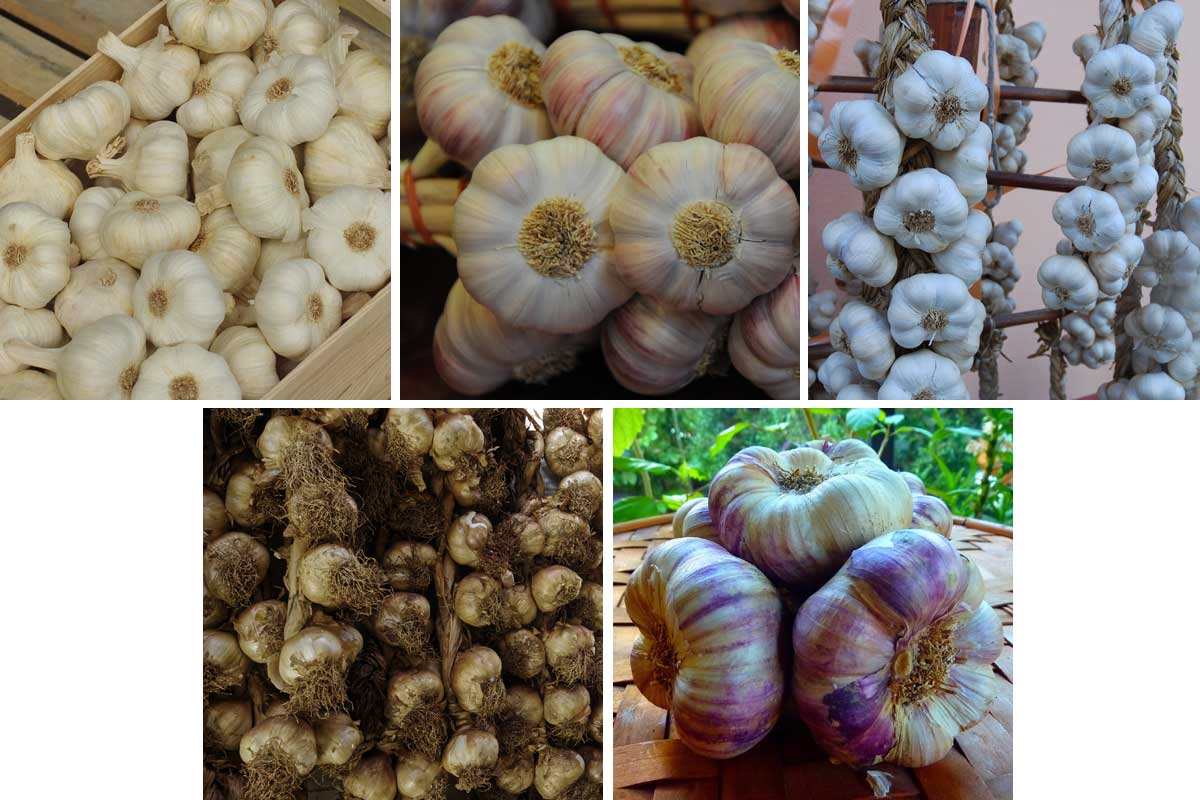 Garlic from Drôme – Pink garlic from Lautrec – White garlic from Lomagne – Smoked garlic from Arleux – Purple garlic from Cadours[/caption>
Garlic from Drôme – Pink garlic from Lautrec – White garlic from Lomagne – Smoked garlic from Arleux – Purple garlic from Cadours[/caption>
Description and Botany
Botanical data
- Latin name Allium sativum
- Family Amaryllaceae or Liliaceae
- Common name Garlic
- Flowering perennial grown as annual or biennial
- Height the bulbils can be stored for several months
- Exposure sun
- Soil type loose, light, draining quickly
- Hardiness hardy
Garlic is a plant native to various regions of the globe, believed to originate from Central Asia, the Mediterranean, the Caucasus, and Afghanistan. The earliest traces of garlic cultivation date back 5000 years to ancient Egypt, where it was consumed by the builders of the pyramids to enhance their strength and immune defenses. Its cultivation then spread through the Greeks and Romans, progressing throughout the rest of Europe.
The common name “garlic” comes from the Latin name, Allium, the origin of which is uncertain. It is thought to derive from the Latin olere, “to smell” or from the Greek hallesthai, “to rise”. Garlic was referred to by the Greeks as “scorodon”. The species name, sativum, means “cultivated”. A garlic… garlics or garlics. Both plural forms are accepted. The first version is older, while the second, initially used in botany, is becoming more common.
Garlic – Allium sativum var. sativum – is a root vegetable from the Liliaceae or Amaryllidaceae family (in phylogenetic classification) like onion, shallot, and leek. This herbaceous, monocotyledonous plant is a bulbous perennial very hardy but is cultivated as an annual or biennial plant. Garlic appears in the form of a bulb or “head”, composed of several cloves called bulbils. These are planted in the ground and develop into new garlic heads.
The erect, linear leaves sheath the stems and are fragrant when crushed. Some garlic varieties form an inflorescence, such as the variety ‘Rose de Lautrec’. Others fail to produce a flower stalk, particularly white garlic varieties like ‘Thermidrome’ and ‘Germidour’. An original classification of cultivated garlic varieties is divided into five groups based on their enzymatic profile and botanical characteristics. The presence or absence of the flower stalk is included in this classification. From the flower stalk, which can reach 30 to 80 cm in height, an umbel blooms, with flowers, mostly sterile, that are white or pink and flower in summer. Between the flowers are floral bulbils that fall to the ground and give rise to new plants, particularly in the case of rocambole garlic.

Garlic heads with the bulbils clearly visible – garlic plant in cultivation
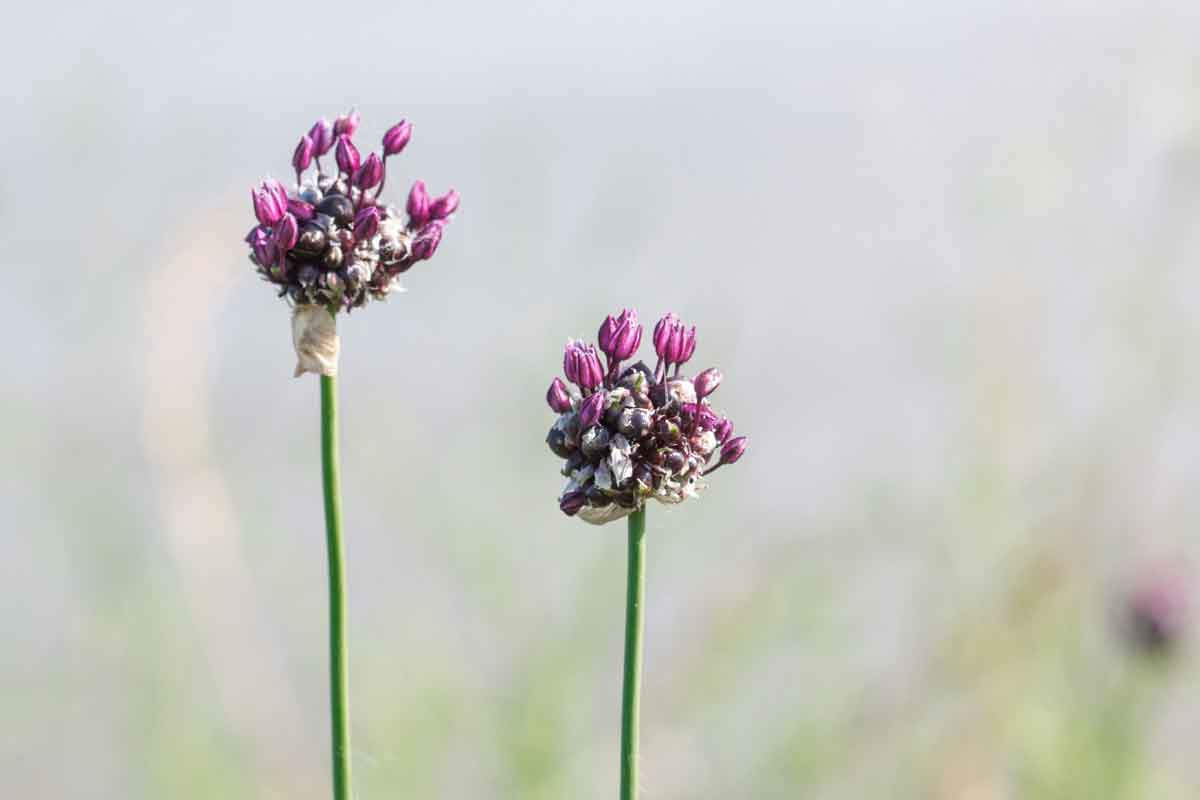
The flowers of rocambole garlic are interspersed with bulbils
Garlic varieties
The choice of varieties is based on a primary criterion: the planting season. White and purple garlic varieties are planted in autumn, while pink varieties are planted in spring. Other species, such as rocambole garlic and wild garlic, which are perennial, can remain in the garden for several years.
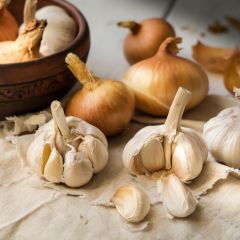
Spring Garlic - Allium sativum
- Height at maturity 30 cm

Gayant Pink Garlic plants - Allium sativum
- Height at maturity 30 cm
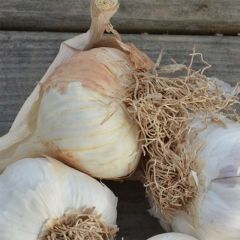
Arno Pink Garlic - Allium sativum
- Height at maturity 30 cm
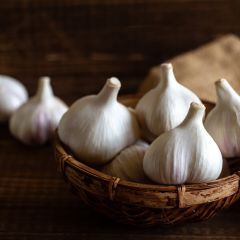
Garlic Flavor - Allium sativum
- Height at maturity 30 cm
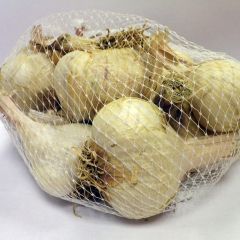
Germidour Garlic plants (autumn planting) - Allium sativum
- Height at maturity 30 cm
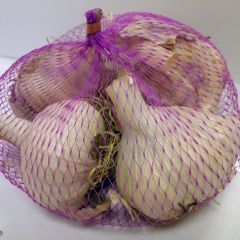
Messidrome Garlic plants (autumn planting) - Allium sativum
- Height at maturity 30 cm
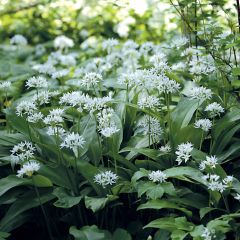
Bear's Garlic - Allium ursinum
- Flowering time May, June
- Height at maturity 20 cm
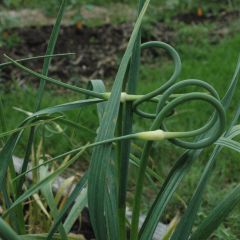
Rocambole Garlic - Allium scorodoprasum
- Height at maturity 80 cm
Discover other Garlic Heads
View all →Available in 2 sizes
Available in 2 sizes
Available in 2 sizes
Available in 1 sizes
Available in 1 sizes
Available in 1 sizes
Available in 1 sizes
Available in 1 sizes
Available in 1 sizes
Available in 2 sizes
Planting garlic
Where and when to plant garlic?
Garlic is planted directly in place in a plot exposed to sunlight and in light, well-drained soil without fresh manure. The rotation for garlic is 5 years, and it is important to avoid growing it after vegetables from the same family (chives, shallots, onions, and leeks).
Garlic fears excess moisture that causes the bulbs to rot. If your soil is very wet, we recommend planting garlic on mounds 10 to 15 cm high, which facilitates water drainage.
Garlic can be planted in spring or autumn:
- from October to December for white and purple garlic,
- in February and March for pink garlic.
How to plant garlic?
To start, prepare the plot by loosening the soil with a broad fork or spading fork, level it with a rake, remove the adventive plants (weeds), and then proceed to planting:
- Dig furrows 3 to 4 cm deep, with rows spaced 25 cm apart.
- Choose, preferably, the bulbil located around the edge of the garlic head, as those in the centre are less productive.
- Plant them every 12 cm, point upwards, pushing them in slightly.
- The bulbs from the centre can be planted closer together (10 cm) or planted in associations (see below, “Associating garlic in the vegetable garden”).
- Cover with a little fine soil using a rake, the tip should be level with the soil!
- Watering is not necessary; seasonal moisture is sufficient.
Associating garlic with the vegetable garden
Garlic gets along well with plants from the Rosaceae family; it notably prevents fungal diseases affecting fruit trees and red fruits such as apple trees, pear trees, peach trees, raspberry bushes, strawberry plants, as well as roses. For better quality tomatoes, it is recommended to plant a head of garlic at the base of each tomato plant. Use the central bulbils from the pod wisely for these associations, keeping the outer bulbils for your garlic ranks intended for consumption.
Garlic can also be a bad companion for certain vegetables. Indeed, it is acknowledged by many gardeners that Fabaceae (the family of beans, broad beans, and peas) and Brassicaceae (cabbages, turnips, rocket, radishes) do not appreciate the presence of garlic and other plants from the Liliaceae family in general. Therefore, avoid these neighbourhoods.
Cultivation and care of garlic
Weed and hoe regularly, especially at the beginning of the growing season. Weeding should be gentle and shallow near the young plants, as the roots of garlic grow close to the surface.
Watering garlic should only be done in case of prolonged drought, starting from May. It is possible to mulch with light soil from May onwards, when the soil is warm enough. For this, it is preferable to use dry mulches such as straw. Absolutely avoid wet herb!
Avoid growing garlic next to leeks or onions, which are susceptible to the same diseases.
Never spray nettle manure on garlic, as the smell of this extract attracts the onion fly.
Some gardeners tie or lay down the foliage two weeks before harvest to concentrate the sap in the bulb and thus increase the size of the bulbs. This is a fairly common practice, but it is not scientifically proven that it actually makes the bulbs grow larger. Another advantage of this action would be to dry the foliage more quickly as harvest approaches.
→ Learn more in our tutorial: How to harvest and store garlic?
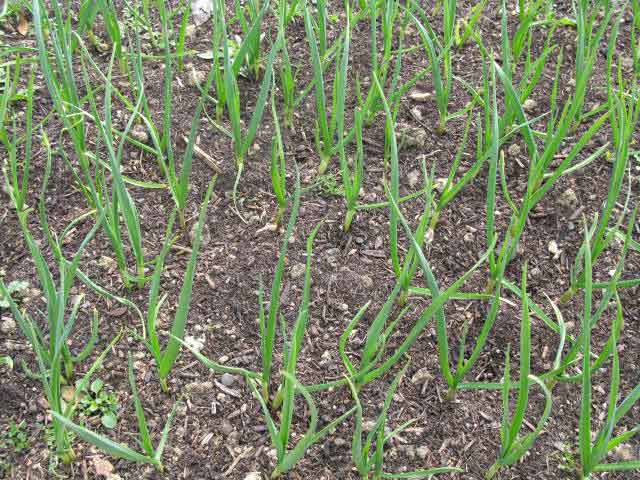
Garlic in the process of growing
Common diseases and pests of garlic
Garlic Rust
It is ironic for this vegetable, known for its excellent anti-fungal properties, to be so susceptible to rust, a disease caused by a fungus!
The agent responsible for rust is the fungus Puccinia allii, which thrives in humid weather and when temperatures are around 18°C. It is mainly encountered in the spring, and depending on the severity of the attack, this disease can significantly affect the harvest. However, if rust appears a few weeks before the harvest, its impact will not be substantial. There are certain environments where this disease is particularly common and virulent.
The symptoms are easy to spot, manifesting as small rust-coloured spots, pustules that appear on the leaves. In cases of severe infestation, the spots merge and eventually completely dry out the leaves, which inevitably affects the development of the bulbils.
To combat garlic rust:
- Preventively, avoid wetting the foliage during watering.
- It is obligatory to respect a rotation period of 4 to 5 years between two garlic crops (as well as with other vegetables in the family).
- In biodynamics, a horsetail decoction is used to prevent its occurrence. Indeed, horsetail keeps the fungus in its environment, that is, in the soil.
- If the disease develops, do not wait for it to spread; cut away the affected parts while avoiding touching the pustules to prevent contaminating the healthy parts. Dispose of the infected parts.
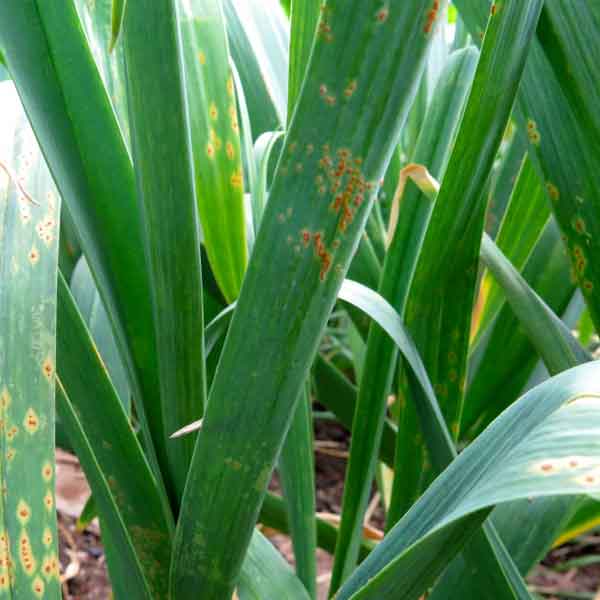 Rust pustules on garlic leaf[/caption>
Rust pustules on garlic leaf[/caption>
Onion Fly
The onion fly – Delia antiqua – is a pest that attacks garlic and can cause a significant loss of harvest. It is the larvae of the fly that cause damage. This manifests as a general weakening of the plant’s vigor. The leaves turn yellow, and the plant eventually dies. Upon noticing these symptoms, simply digging up the contaminated plant reveals that the maggots are feeding on the bulb. Contaminated plants must be destroyed to prevent the spread of the larvae. Unfortunately, the larvae have this incredible ability to move from one plant to another!
To prevent attacks from the onion fly:
- It is particularly important to not apply nettle manure to the garlic crop, as the smell of this manure attracts the fly.
- Tansy infusion is a good preventive treatment.
- Insect netting remains the best solution, to be used if the problem is recurrent in your vegetable garden.
Harvesting and storing Garlic
Garlic is harvested at different stages depending on its ripeness from April to July:
- The harvest of young garlic (from the planting of inner bulbils) occurs when the stems measure 20 to 30 cm.
- The green harvest takes place for autumn garlic (white and purple garlic) in April and May, when it is still green and the pod is formed but not the bulbils.
- The garlic flower (from pink varieties) is harvested in May and June.
- The dry harvest occurs when the leaves wither. Pull up the bulbs and let them dry for a few days in a dry, shaded area (to avoid sunburn). They can be braided for hanging to aid in drying.
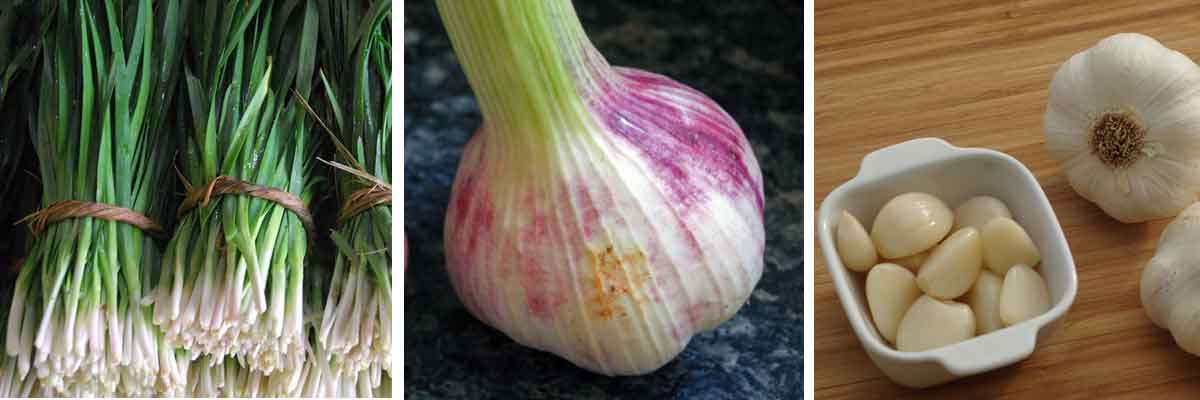 Garlic is harvested at different stages: Young garlic – Green garlic – Dry garlic[/caption>
Garlic is harvested at different stages: Young garlic – Green garlic – Dry garlic[/caption>
Garlic heads can be stored for several months and up to a year. Pink and purple varieties store better than white garlic.
To properly store dry garlic:
-
- store garlic away from light preferably to prevent the pods from greening over time.
-
- Place them in a ventilated room to limit the risk of mould.
-
- Damaged bulbs should be set aside and consumed first to prevent them from contaminating the other pods.
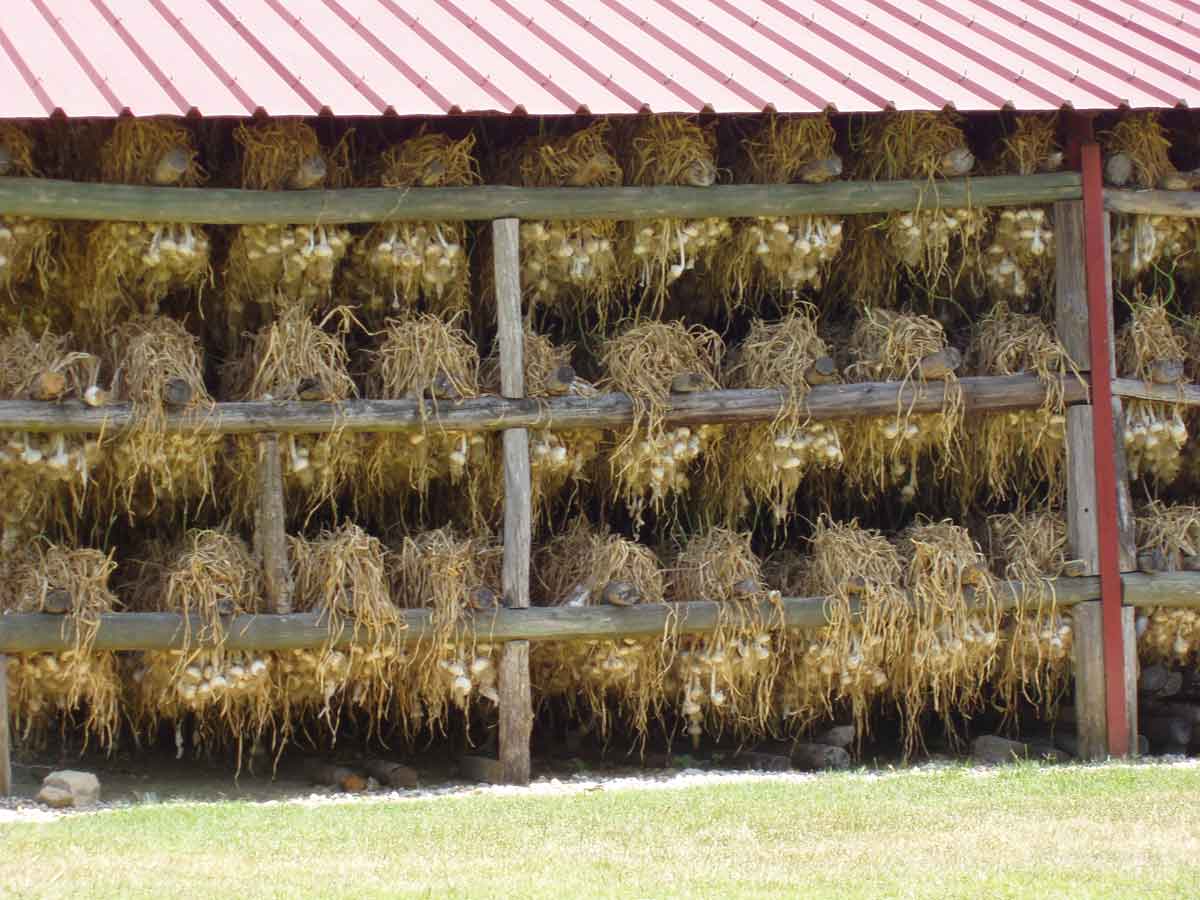 Drying garlic is important for proper bulb storage.
Drying garlic is important for proper bulb storage.
Uses and benefits
Garlic is an essential ingredient in many dishes and sauces; it is a key component of aioli, the famous Mediterranean sauce, as well as rouille, which enhances bouillabaisse, not to mention escargot butter. In spring, enjoy harvesting your young garlic to consume it raw by mixing it into salads or adding it to dishes at the end of cooking. With the harvest at ripeness, there is no need to remove the shoots in the first months; later, when the shoots form, removing the shoots makes garlic more digestible. It is used finely chopped or minced with a garlic press and always added at the end of cooking to benefit from its flavour and its many health benefits.
We are all equal when it comes to temporary halitosis caused by garlic, but despite this drawback, this powerful condiment has multiple health benefits. It is possible to attenuate bad breath by consuming parsley! Pink garlic is also milder than white garlic.
Garlic is very rich in selenium and sulphur compounds, including many antioxidants. It contains a good amount of vitamins A, B, and C. It is an excellent prebiotic due to its inulin content. It is highly likely that Lebanese garlic sauce (made with yoghurt) would be ideal for strengthening intestinal flora! It is also known for its powerful antibacterial and antiviral effects, particularly against the cold virus. Garlic is also very good for the heart; it thins the blood, lowers blood pressure, and reduces cholesterol levels. According to various scientific studies, daily consumption of garlic could halve the risk of digestive cancers, including those of the stomach, colon, and rectum, but it should be consumed raw.
→ Discover also the garlic manure or garlic decoction: recipe and uses in the garden and How to make 100% homemade garlic powder? in our tutorials!
Useful resources
- Discover our range of garlic, available as bulbs for common garlic, young plants or seeds for wild garlic.
- Our advice sheet: Garlic, the best varieties
- Garlic and rocambole onion: how to successfully grow two perennial vegetables
- How to multiply garlic? Our tips and techniques
Frequently asked questions
-
My garlic pods are becoming translucent, what is happening? Are they edible?
A clove of garlic that becomes translucent is due to mould. This translucent garlic is no longer consumable; in fact, just smelling it will reveal that the odour is no longer characteristic of healthy garlic. We recommend storing your garlic in a well-ventilated place after the harvest.
- Subscribe!
- Contents

































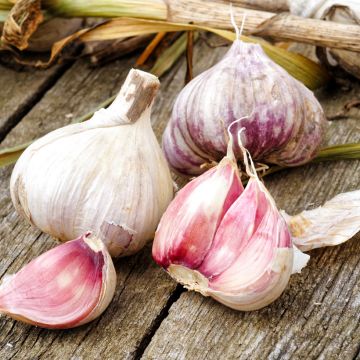
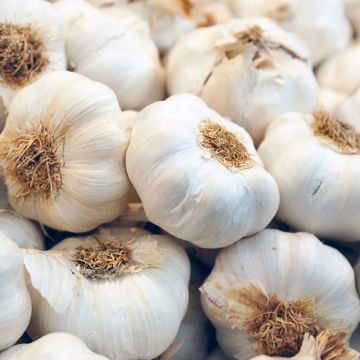
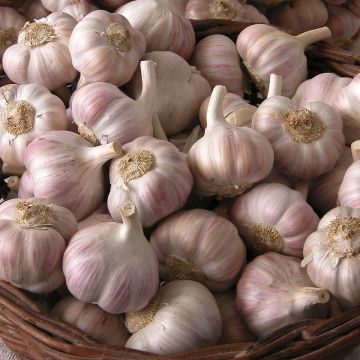


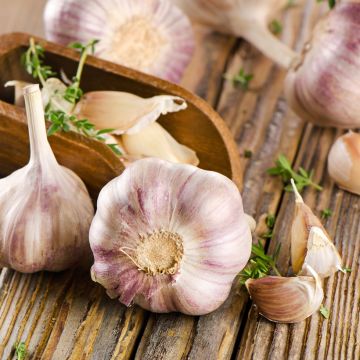
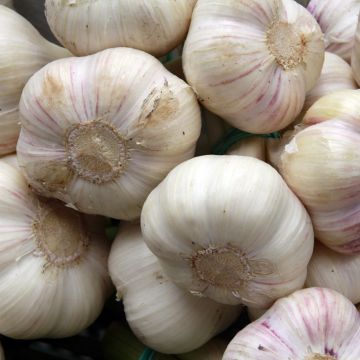
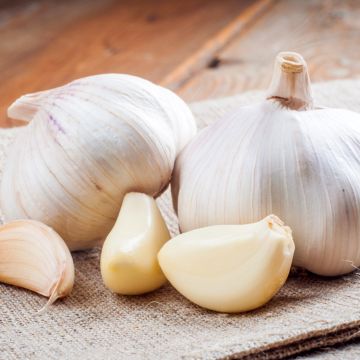
Comments